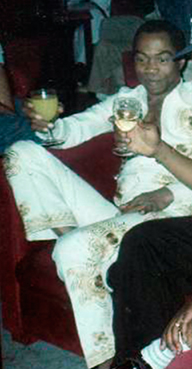This is Part 4 of an ongoing series. In Part 3, Moyo wrote about his first marriage, his son and coming to the United States.
I come from a huge family, a country bordering three continents, and my experiences are vast. I will be sharing them in time. In the great tradition of Alex Haley, one of the greatest writers America has ever seen, I continue this series.
When I first met Mr. Fela Kuti — the creator of the musical style “Afro Beat,” a multi-instrumentalist and leader of an 18-piece orchestra called “Fela and the Egypt 80″— I believe I was 13 years old.
Fela’s mother, Funmilayo Ransome-Kuti, a women’s rights activist, took me to see him on a street named after his father, Israel Oludotun Ransome-Kuti, the principle of the only grammar school in the country at that time. The car we drove was a Volvo. I remember it had a strange horn, something your car really needed in Lagos, Nigeria, because of the constant traffic jams.
It was 1977. Fela was in his late 30s. This “fella” had hands the size of two gorilla paws and was very wealthy. As young as he was, Fela already had several albums to his credit.
As I entered his estate, a series of adjoining compounds, I saw Paul McCartney (of Beatles fame) come into the room. A cultural festival was going on that had invited artists, dancers, musicians and sculptures from all over Africa. The centerpiece was carved by Nigerian Yoruba master carver Olowe of Ise, whose work sits on the fourth floor of the Smithsonian’s new National Museum of African American History and Culture, in Washington, D.C. The event, called FESTAC, was the costliest festival to have been celebrated on the African continent. It is what made Fela a household name.
Fela was advocating mainly to install African pride in his people at that point. He used to ride on a donkey on a street named after his family to his African shrine, Calcutta. It was called this because the slums where the poor lived reminded him of Calcutta, India — now Kolkata. As he road, the people used to throw leaves underneath the feet of the donkey. This was at the height of his fame. I call this his pre-advocacy period. It was after his house was burnt down by the military that Fela shifted into high gear on issues of poverty and homelessness.
He was banned from entering Ghana by the Ghanaian president for inciting Ghanaian university students to revolt. He started a daily column in the national newspaper, “Chief Priest Speaks,” in which he lambasted authorities for corruption and the neglect of millions of homeless and poor Africans. Even today in Nigeria, this is still a massive problem.
In 1977, the military government invested billions of dollars in building numerous fancy theatres to house the millions of Africans and visiting heads of states. Fela complained that the money could better be used to feed the teeming masses of poor and homeless, much the same way that I complained about the two tons of food I used to pick up and trash from Congress every morning on the truck I worked for from 2002 to 2005.
A Nigerian supreme court lawyer’s daughter moved away from her parents into Fela’s house, which caused a massive scandal and put Fela on the radar of the judges and the military. He was the most fearless advocate that ever lived. He operated a no-man’s-land policy, under a corrupt and oppressive military regime. And no one could do anything about it in Nigeria.
So Fela formed an intimate part of my life and growing up experiences, from his music to advocacy for the poor and homeless to 200 beatings and 12 imprisonments (which knocked years off his musical output) to his living in abject poverty. The Nigerian nickname for Fela Kuti was “Ebami Eda,” which simply means “chief priest.”
In looking at my life in retrospect, I can understand that my story has been, at times, as tumultuous as Fela’s. Having been arrested not once in England or Africa but countless times in Washington, D.C., often on trumped-up charges. I’ve been beaten up many times for my outspokenness, although not tortured, yet. One needs to be prepared for that these days. Though some people say jail is a form of torture. As I approach mid-life, I aim to chronicle in this series all of the main incidents that have shaped me and all of the emotions that have been stirred up in me over the years. Nonetheless, I cannot write about myself without writing about a man whose music and words came directly from the other world.
In the next part: I will look at my work managing the destruction and recycling of classified and declassified documents out of government buildings such as the U.S. Capitol, the U.S. Supreme Court and others.




